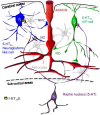Activation of cortical 5-HT(3) receptor-expressing interneurons induces NO mediated vasodilatations and NPY mediated vasoconstrictions
- PMID: 22907992
- PMCID: PMC3415676
- DOI: 10.3389/fncir.2012.00050
Activation of cortical 5-HT(3) receptor-expressing interneurons induces NO mediated vasodilatations and NPY mediated vasoconstrictions
Abstract
GABAergic interneurons are local integrators of cortical activity that have been reported to be involved in the control of cerebral blood flow (CBF) through their ability to produce vasoactive molecules and their rich innervation of neighboring blood vessels. They form a highly diverse population among which the serotonin 5-hydroxytryptamine 3A receptor (5-HT(3A))-expressing interneurons share a common developmental origin, in addition to the responsiveness to serotonergic ascending pathway. We have recently shown that these neurons regroup two distinct subpopulations within the somatosensory cortex: Neuropeptide Y (NPY)-expressing interneurons, displaying morphological properties similar to those of neurogliaform cells and Vasoactive Intestinal Peptide (VIP)-expressing bipolar/bitufted interneurons. The aim of the present study was to determine the role of these neuronal populations in the control of vascular tone by monitoring blood vessels diameter changes, using infrared videomicroscopy in mouse neocortical slices. Bath applications of 1-(3-Chlorophenyl)biguanide hydrochloride (mCPBG), a 5-HT(3)R agonist, induced both constrictions (30%) and dilations (70%) of penetrating arterioles within supragranular layers. All vasoconstrictions were abolished in the presence of the NPY receptor antagonist (BIBP 3226), suggesting that they were elicited by NPY release. Vasodilations persisted in the presence of the VIP receptor antagonist VPAC1 (PG-97-269), whereas they were blocked in the presence of the neuronal Nitric Oxide (NO) Synthase (nNOS) inhibitor, L-NNA. Altogether, these results strongly suggest that activation of neocortical 5-HT(3A)-expressing interneurons by serotoninergic input could induces NO mediated vasodilatations and NPY mediated vasoconstrictions.
Keywords: Pet1 knock-out mouse; U46619; brain slices; mCPBG; neurogliaform cells; neurovascular coupling; serotonin; vasoactive intestinal peptide.
Figures









Similar articles
-
Revisiting enigmatic cortical calretinin-expressing interneurons.Front Neuroanat. 2014 Jun 24;8:52. doi: 10.3389/fnana.2014.00052. eCollection 2014. Front Neuroanat. 2014. PMID: 25009470 Free PMC article. Review.
-
Serotonin 3A receptor subtype as an early and protracted marker of cortical interneuron subpopulations.Cereb Cortex. 2010 Oct;20(10):2333-47. doi: 10.1093/cercor/bhp310. Epub 2010 Jan 18. Cereb Cortex. 2010. PMID: 20083553 Free PMC article.
-
Cortical GABA interneurons in neurovascular coupling: relays for subcortical vasoactive pathways.J Neurosci. 2004 Oct 13;24(41):8940-9. doi: 10.1523/JNEUROSCI.3065-04.2004. J Neurosci. 2004. PMID: 15483113 Free PMC article.
-
Classification of NPY-expressing neocortical interneurons.J Neurosci. 2009 Mar 18;29(11):3642-59. doi: 10.1523/JNEUROSCI.0058-09.2009. J Neurosci. 2009. PMID: 19295167 Free PMC article.
-
Neuropeptide Y and neurovascular control in skeletal muscle and skin.Am J Physiol Regul Integr Comp Physiol. 2009 Sep;297(3):R546-55. doi: 10.1152/ajpregu.00157.2009. Epub 2009 Jul 1. Am J Physiol Regul Integr Comp Physiol. 2009. PMID: 19571208 Free PMC article. Review.
Cited by
-
Revisiting enigmatic cortical calretinin-expressing interneurons.Front Neuroanat. 2014 Jun 24;8:52. doi: 10.3389/fnana.2014.00052. eCollection 2014. Front Neuroanat. 2014. PMID: 25009470 Free PMC article. Review.
-
NPY+-, but not PV+- GABAergic neurons mediated long-range inhibition from infra- to prelimbic cortex.Transl Psychiatry. 2016 Feb 16;6(2):e736. doi: 10.1038/tp.2016.7. Transl Psychiatry. 2016. PMID: 26882036 Free PMC article.
-
Parvalbumin interneuron activity induces slow cerebrovascular fluctuations in awake mice.bioRxiv [Preprint]. 2024 Jun 16:2024.06.15.599179. doi: 10.1101/2024.06.15.599179. bioRxiv. 2024. PMID: 38915522 Free PMC article. Preprint.
-
Optogenetic assessment of VIP, PV, SOM and NOS inhibitory neuron activity and cerebral blood flow regulation in mouse somato-sensory cortex.J Cereb Blood Flow Metab. 2020 Jul;40(7):1427-1440. doi: 10.1177/0271678X19870105. Epub 2019 Aug 16. J Cereb Blood Flow Metab. 2020. PMID: 31418628 Free PMC article.
-
Interneurons contribute to the hemodynamic/metabolic response to epileptiform discharges.J Neurophysiol. 2016 Mar;115(3):1157-69. doi: 10.1152/jn.00994.2014. Epub 2015 Dec 23. J Neurophysiol. 2016. PMID: 26745250 Free PMC article.
References
-
- Abounader R., Elhusseiny A., Cohen Z., Olivier A., Stanimirovic D., Quirion R., Hamel E. (1999). Expression of neuropeptide Y receptors mRNA and protein in human brain vessels and cerebromicrovascular cells in culture. J. Cereb. Blood Flow Metab. 19, 155–163 10.1097/00004647-199902000-00007 - DOI - PubMed
-
- Ascoli G. A., Alonso-Nanclares L., Anderson S. A., Barrionuevo G., Benavides-Piccione R., Burkhalter A., Buzàki G., Cauli B., Defelipe J., Faién A., Feldmeyer D., Fishell G., Fregnac Y., Freund T. F., Gardner E. P., Goldberg J. H., Helmstaedter M., Hestrin S., Karube F., Kisvàrday Z. F., Lambolez B., Lewis D. A., Marin O., Markram H., Munoz A., Packer A., Petersen C. C., Rockland K. S., Rossier J., Rudy B., Somogy P., Staiger J. F., Tamas G., Thomson A. M., Toledo-Rodriguez M., Wang Y., West D. C., Yuste R. (2008). Petilla terminology: nomenclature of features of GABAergic interneurons of the cerebral cortex. Nat. Rev. Neurosci. 9, 557–568 10.1038/nrn2402 - DOI - PMC - PubMed
LinkOut - more resources
Full Text Sources
Molecular Biology Databases
Miscellaneous

